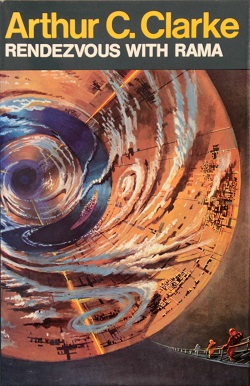As is the case with most people, my first introduction to Clarke was being shown the film ‘2001 A Space Odyssey’ when I was young…and not understanding it one bit. However, I think it’s true to say that those experiences often stick in your head the most and breed a certain curiosity in you. So, after breaking into the Isaac Asimov universe with ‘Foundation’, I now took on Arthur C. Clark. I spent the first half of the reading of Rama thinking that it was the book on which ‘2001’ was based. Where I got that information, I have no idea but thanks to Rob Agar and his in-depth film analyses, I found out that it was in fact a book called ‘The Sentinel’ which inspired ‘2001’.
See his brilliant analysis of the Monolith in 2001 here:
The book, which is split into many small chapters, each dealing with a certain subject or event, takes us through technicalities, future interplanetary political strife (Mars, the Moon and even Mercury has been colonised and have separate governments) and so much visual science fiction wonderment. Clarke’s power as a writer is not in creating poetry like Herman Melville, or perplexing characters like Asimov (that sort of sounds like I’m name dropping but whatever), his strength is the pure invention: you believe that everything he writes is possible, and in some cases, even likely! It’s no surprise that he is called a sci fi prophet, he would probably still be considered so even if he had never written about satellites in orbit as early as the 1940’s:
“He described this concept in a paper titled "Extra-Terrestrial Relays — Can Rocket Stations Give Worldwide Radio Coverage?", published in 'Wireless World' in October 1945.” (Wikipedia)
Anyway, this blogger has got himself a second hand copy of the sequel, ‘Rama II’ and after a successful completion of Kurt Vonnegut’s ‘Mother Night’, (thanks Steve) I’m getting well into that!
‘Rendezvous With Rama’ by Arthur C. Clarke.
Rating: 9/10
By Edward Gerard Brophy for Born Again Nihilist 2011.
bornagainnihilist@gmail(dot)com


No comments:
Post a Comment